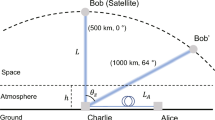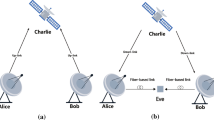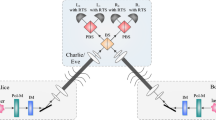Abstract
The reference-frame-independent quantum key distribution (RFI-QKD) allows the authorized users to share secrete keys without active alignment of the reference frames, which is beneficial for the implementation over free-space channel. However, the performance of free-space RFI-QKD could notably degrade due to the influence of atmospheric conditions. In this paper, we investigate the transmission attenuation of free-space channel in uplink and downlink scenario, respectively. Furthermore, we also simulate the relationships between the diffraction-caused attenuation and the apertures of sending and receiving optics. Then, the key generation rate of RFI-QKD and BB84 protocol are compared in different links with reference frame deviations. Simulation results show that the transmission attenuation due to diffraction can be reduced by choosing appropriate optical apertures, and better performance of free-space RFI-QKD can be achieved in downlink configuration.




Similar content being viewed by others
References
Bennett, C.H., Brassard, G.: Quantum cryptography: public key distribution and coin tossing. In: Proceedings of IEEE international conference on computers, systems, and signal processing, Bangalore, India, 10-19 December 1984, pp 175-179 (1984)
Hwang, W.Y.: Quantum key distribution with high loss: toward global secure communication. Phys. Rev. Lett. 91(5), 057901 (2003)
Lo, H.K., Ma, X., Chen, K.: Decoy state quantum key distribution. Phys Rev Lett. 94(23), 230504 (2005)
Zhang, Q., Xu, F., Chen, Y.A., et al.: Large scale quantum key distribution: challenges and solutions. Opt. Express. 26(18), 24260–24273 (2018)
Fan-Yuan, G.J., Wang, C., Wang, S., et al.: Afterpulse analysis for quantum key distribution. Phys. Rev. Appl. 10(6), 064032 (2018)
Yin, Z.Q., Wang, S., Chen, W., et al.: Improved security bound for the round-robin-differential-phase-shift quantum key distribution. Nat. Commun. 9(1), 457 (2018)
Lucamarini, M., Yuan, Z.L., Dynes, J.F., et al.: Overcoming the rate-distance barrier of quantum key distribution without using quantum repeaters. Nature 557(7705), 400–403 (2018)
Lu, F.Y., Yin, Z.Q., Cui, C.H., et al.: Improving the performance of twin-field quantum key distribution. Phys. Rev. A. 100(2), 022306 (2019)
Lo, H.K., Curty, M., Qi, B.: Measurement-device-independent quantum key distribution. Phys. Rev. Lett. 108(13), 130503 (2012)
Acin, A., Brunner, N., Gisin, N., et al.: Device-independent security of quantum cryptography against collective attacks. Phys. Rev. Lett. 98(23), 230501 (2007)
Mower, J., Zhang, Z., Desjardins, P., et al.: High-dimensional quantum key distribution using dispersive optics. Phys. Rev. A. 87(6), 062322 (2013)
Sasaki, T., Yamamoto, Y., Koashi, M.: Practical quantum key distribution protocol without monitoring signal disturbance. Nature. 509(7501), 475 (2014)
Fan-Yuan, G.J., Teng, J., Wang, S.: Optimizing singlephoton avalanche photodiodes for dynamic quantum key distribution networks. Phys. Rev. Appl. 13(5), 054027 (2020)
Schmitt-Manderbach, T., Weier, H., Fuerst, M., et al.: Experimental demonstration of free-space decoy-state quantum key distribution over 144 km. Phys. Rev. Lett. 98(1), 010504 (2007)
Yin, H.L., Chen, T.Y., Yu, Z.W., et al.: Measurement-device-independent quantum key distribution over a 404 km optical fiber. Phys. Rev. Lett. 117(19), 190501 (2016)
Minder, M., Pittaluga, M., Roberts, G.L., et al.: Experimental quantum key distribution beyond the repeaterless secret key capacity. Nat. Photon. 13 (5), 334 (2019)
Liao, S.K., Cai, W.Q., Handsteiner, J., et al.: Satellite-relayed intercontinental quantum network. Phys. Rev Lett. 120(3), 030501 (2018)
Qiu, J.: Quantum communications leap out of the lab. Nature. 508 (7497), 441–442 (2014)
Simon, C.: Towards a global quantum network. Nat. Photon. 11 (11), 678–680 (2017)
Kurtsiefer, C., Zarda, P., Halder, M., et al.: Quantum cryptography: a step towards global key distribution. Nature. 419(6906), 450 (2002)
Diamanti, E., Lo, H.K., Qi, B., et al.: Practical challenges in quantum key distribution. Npj. Quantum Inform. 2, 16025 (2016)
Liao, S.K., Cai, W.Q., Liu, W.Y., et al.: Satellite-to-ground quantum key distribution. Nature. 549(7670), 43–47 (2017)
Pirandola, S., Andersen, U.L., Banchi, L., et al.: Advances in quantum cryptography. arXiv:1906.01645 (2019)
Chen, J.P., Zhang, C., Liu, Y., et al.: Sending-or-not-sending with independent lasers: secure twin-field quantum key distribution over 509km. Phys. Rev. Lett. 124(7), 070501 (2020)
Yin, J., Cao, Y., Li, Y.H., et al.: Satellite-based entanglement distribution over 1200 kilometers. Science. 356(6343), 1140–1144 (2017)
Yang, A.L., Gao, J., Ji, L., et al.: Towards quantum communications in free-space seawater. Opt. Express. 25(17), 19795–19806 (2017)
Bouchard, F., Alicia, S., Felix, H., et al.: Quantum cryptography with twisted photons through an outdoor underwater channel. Opt. Express. 26(17), 22563 (2018)
Wang, J.Y., Yang, B., Liao, S.K., et al.: Direct and full-scale experimental verifications towards ground satellite quantum key distribution. Nat. Photon. 7(5), 387–393 (2013)
Nauerth, S., Moll, F., Rau, M., et al.: Air-to-ground quantum communication. Nat. Photon. 7(5), 382–386 (2013)
Bourgoin, J.P., Higgins, B.L., Gigov, N., et al.: Free-space quantum key distribution to a moving receiver. Opt. Express. 23(26), 33437 (2015)
Pugh, C.J., Kaiser, S., Bourgoin, J.P., et al.: Airborne demonstration of a quantum key distribution receiver payload. Quantum Sci. Technol. 2(2), 024009 (2017)
Hill, A.D., Chapman, J., Herndon, K., et al.: Drone-based quantum key distribution. Urbana. 51, 61801–63003 (2017)
Laing, A., Scarani, V., Rarity, J.G., et al.: Reference frame independent quantum key distribution. Phys. Rev. A. 82(1), 012304 (2010)
Wang, C., Song, X.T., Yin, Z.Q., et al.: Phase-reference-free experiment of measurement-device-independent quantum key distribution. Phys. Rev. Lett. 115(16), 160502 (2015)
Wang, F., Zhang, P., Wang, X., et al.: Valid conditions of the reference-frame-independent quantum key distribution. Phys. Rev. A. 94 (6), 062330 (2016)
Zhang, C.M., Zhu, J.R., Wang, Q.: Practical decoy-state reference-frame-independent measurement-device-independent quantum key distribution. Phys. Rev. A. 95(3), 032309 (2017)
Zhang, C.M., Wang, W.B., Li, H.W., et al.: Weak randomness impacts the security of reference-frame-independent quantum key distribution. Opt. Lett. 44(5), 1226–1229 (2019)
Wang, C., Sun, S.H., Ma, X.C., et al.: Reference-frame-independent quantum key distribution with source flaws. Phys. Rev. A. 92(4), 042319 (2015)
Tanumoy, P., Byung, K.P., Cho, Y.W., et al.: Robustness of reference-frame-independent quantum key distribution against the relative motion of the reference frames. Phys. Lett. A. 381(31), 2497–2501 (2017)
Wang, X.Y., Zhao, N., Chen, N., et al.: Effects of atmospheric turbulence on the single-photon receiving efficiency and the performance of quantum channel with the modified approximate elliptic-beam model assumption. Quantum Inf. Process. 17(1), 14 (2018)
Aspelmeyer, M., Jennewein, T., Pfennigbauer, M., et al.: Long-distance quantum communication with entangled photons using satellites. IEEE J. Sel. Topics Quantum Electron. 9(6), 1541–1551 (2003)
Sharma, V., Banerjee, S.: Analysis of atmospheric effects on satellite-based quantum communication: a comparative study. Quantum Inf. Process. 18 (3), 67 (2019)
Tomaello, A., Bonato, C., Deppo, V.D., et al.: Link budget and background noise for satellite quantum key distribution. Adv. Space. Res. 47(5), 802–810 (2011)
Andrews, L.C., Philips, R.L., Yu, P.T.: Optical fade statistics for a satellitecommunication system. Appl scintillation Opt. 34(33), 7742–5164 (1995)
Fan-Yuan, G.J., Wang, S., Yin, Z.Q., et al.: Modeling alignment error in quantum key distribution based on a weak coherent source. Phys. Rev. Appl. 12(6), 064044 (2019)
Wang, X.B.: Decoy-state protocol for quantum cryptography with four different intensities of coherent light. Phys. Rev. A. 72(1), 012322 (2005)
Acknowledgements
The authors would like to thank C.M. Zhang from the Nanjing University of Posts and Telecommunications for helpful discussion. We gratefully acknowledge the financial support from the National Natural Science Foundation of China through Grants Nos.61971436, 61803382; the Natural Science Basic Research Plan in Shaanxi Province through Grant No. 2018JQ6020; the China Postdoctoral Science Foundation Funded Project through Grant No. 2018M643869.
Author information
Authors and Affiliations
Corresponding author
Additional information
Publisher’s Note
Springer Nature remains neutral with regard to jurisdictional claims in published maps and institutional affiliations.
Appendix
Appendix
Suppose that two single-photon detectors are used at the receiver’s side, the total gain and QBER of λ intensity states in ζ basis can be given as
according to the binomial principle, the successful probability of detecting Alice’s state in Bob’s basis of n-photon pulse is expressed as
P(m) means the probability of valid detection events. When m = 0, \(P(m)=P_{d}-{{P}_{d}^{2}}\approx P_{d}\), when m > 0, P(m) = 1 − Pd. Pd is the dark counts of a single-photon detector. The above calculations are also applied to the decoy state (λ = ν) and vacuum state (λ = 0). It can be acquired intuitively that the gain and error rate of vacuum states are Q0 = 2Pd(1 − Pd) and \(Q^{0}E^{0}=\frac {1}{2}Q^{0}\).
For non-vacuum states, the total gain of intensity λ is half of the total probability of all kinds of detection events and the quantum bit error is half of the wrong detection events probability. For example,
In order to get the final key rate we also need to evaluate the upperbound of single-photon error rate and the lowerbound of its gain, which are given as
The formula also apply to the other basis combination to calculate (16).
Rights and permissions
About this article
Cite this article
Xue, Y., Shi, L., Wei, J. et al. Reference-Frame-Independent Quantum Key Distribution in Uplink and Downlink Free-Space Channel. Int J Theor Phys 59, 3299–3309 (2020). https://doi.org/10.1007/s10773-020-04587-x
Received:
Accepted:
Published:
Issue Date:
DOI: https://doi.org/10.1007/s10773-020-04587-x




